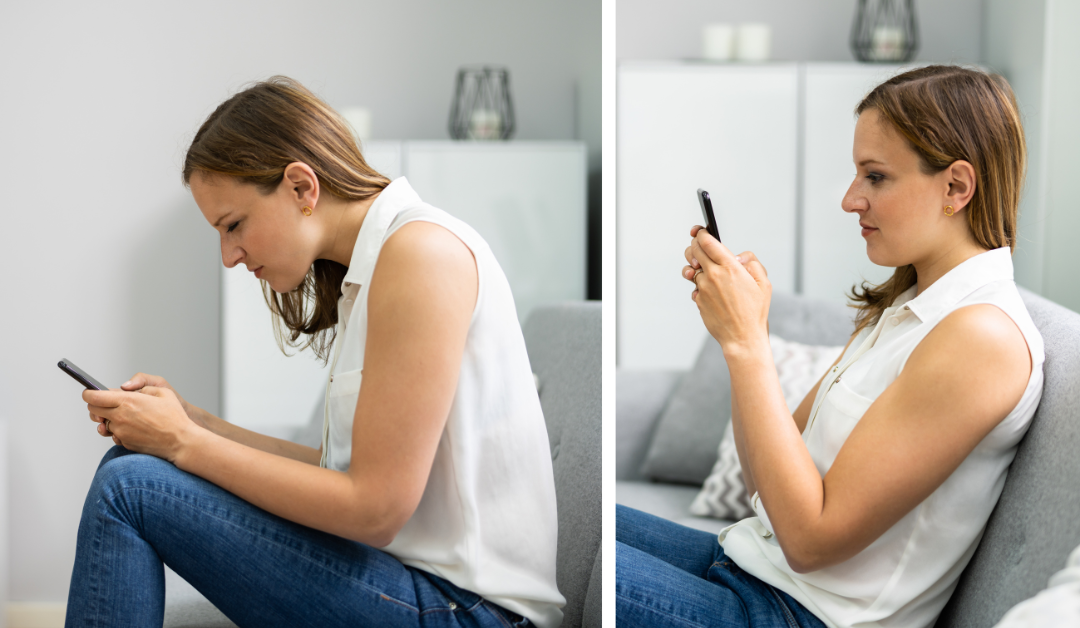Whether you are a 10yr old child playing on an iPad, a student on social media on their phone, or a lawyer working long hours in the office, people are all feeling the pinch of bad posture.
Text neck was previously used as a casual reference to those sitting on their phones all day, however now it has become a serious health issue that we all need to be aware of.
What is Text Neck and what’s it caused from?
Sadly Text Neck is becoming increasingly common.
Whilst not an official medical diagnosis, Text Neck is a term used by health professionals to describe the new repetitive stress injury to the cervical spine and neck. It is primarily caused by excessive use of a mobile device which causes forward head posture, where a person’s head is forward, shoulders rounded and back is slumped.
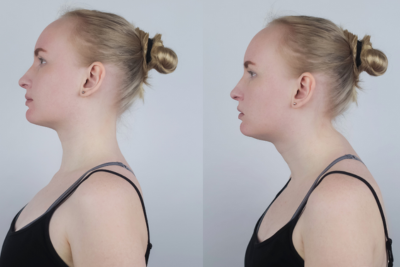
What Effect is Text Neck having on your spine and body?
Did you know… The human head weighs almost 5.4kg? Doesn’t sound too heavy right?
But here’s the thing… For every inch your head is held forwards, an additional 4.5kgs is added! That means those hunched over looking at their phones at about 60 degrees, will be carrying approx 27kg of weight on their neck!
A healthy cervical spine has a natural lordotic curve, which curves forward from the base of the skull and then backward into the top of the chest or upper back.
When the head starts to move forward the lower cervical spine goes into hyperflexion with the curve flattening out,whilst the upper cervical spine goes into hyperextension, with the curve becoming too pronounced.
Text neck compresses and tightens the muscles, tendons and ligaments in the front of the neck, and lengthens those structures behind the neck.
This forward head posture increases pressure on your cervical spine, overloads the muscles and creates a hunched upper back. It also increases the stretching and tension on the spinal cord and nerve roots. Continued forward head posture or text neck, will most likely result in increased neck pain and stiffness and also increased risk of spinal degeneration.
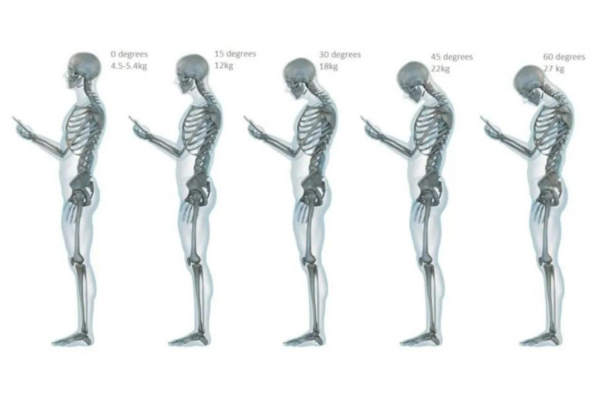
What are the symptoms of Text Neck ?
Symptoms commonly include –
- Pain in the next, upper back and/or shoulder – This can be a general feeling of achiness or soreness over a larger region or an intense stabbing feeling in a specific spot.
- Reduced Mobility – There may be reduced mobility in the neck, upper back or shoulder areas.
- Headaches – Excessive screen time, regardless of posture, can increase the risk of eyestrain and headaches. The muscles in the base of the neck can go into spasm and become painful, and pain can be referred from neck to the head.
Other less common symptoms can include –
- Cervical radiculopathy – This can occur when the cervical nerve root becomes irritated or compressed, like when there are spinal changes from degenerative disc disease or osteoarthritis. Symptoms include electric shock like pain, pins and needles tingling, numbness and possibly weakness that can radiate from the neck down in the shoulder, arm or hand.
- Balance Issues – Forward head posture over long periods of time has been linked to reduced balance control, resulting in muscle imbalances and postural control changes for the neck and torso.
- Jaw Pain – Some people also experience very uncomfortable jaw pain or temporomandibular joint pain (TMJ), due to the misalignment in the cervical spine and muscle imbalances.
If you do experience severe headache, fever, nausea, unexpected weight loss, dizziness, pain or tingling going down your arm or other unexplained symptoms, please see your health professional as soon as possible as there may be a more serious underlying medical condition.
Tips to Prevent Text Neck
The good news is, there are a lot of things you and your family can do at home, work or school!
Here are some general tips to help prevent Text neck from occurring or getting worse –
- Change how you hold your phone – To prevent you holding a forward-head posture for a long period of time, bring your phone to eye level so you aren’t looking down. Your head shouldn’t be slouched forward and you should have a neutral spine with your ears in line with your shoulders. Use could also use a phone or ipad holder instead, especially if you will be using the device for a longer period.
- Take breaks – Make yourself take a break from your phone regularly. An easy way to do this is setting reminders on your phone. During this time arch your neck and upper back and do some simple stretches to ease any muscle pain or tension.
- Increase strength and body awareness – Take up Yoga or Pilates, or an exercise program, that will improve your body awareness and movement patterns. A strong and flexible back and neck, along with a strong core, are much better equipped to take on any new stress or imbalance.
- Massage – Book in a regular massage to help ease the tension in the muscles.
- Use a Cervical Pillow – A cervical pillow is shaped with the center of the pillow curved inward to better support and encourage the natural curves of the cervical spine.
Visit your chosen health professional if pain continues – There are many treatment options for Neck,Shoulder or Back pain. If you are still having pain or discomfort, even after making a conscious effort to improve your habits and posture, please reach out to your Physiotherapist or other health professional before the issue becomes even worse. - Visit your chosen health professional if pain continues – There are many treatment options for Neck,Shoulder or Back pain. If you are still having pain or discomfort, even after making a conscious effort to improve your habits and posture, please reach out to your Physiotherapist or other health professional before the issue becomes even worse.
Exercises for Text Neck and Posture Related Neck and Shoulder Pain
Strengthening and stretching your muscles will help to relieve the pain associated with Text neck. Health professionals are now incorporating exercises like the following, into their treatment recommendations for those suffering from Text Neck or other posture related issues.
An Exaggerated Nod
This counterbalances the forward head position, by forcing you to pull your shoulders down and back and increases neck mobility.
Instructions –
- Start by sitting at a desk, standing relaxed or kneeling on your knees.With mouth closed, teeth gently touching, look up at the ceiling.
- Now let your jaw relax and open your mouth and try to bring your head further back.
- Staying there, bring your lower jaw to upper jaw and close your mouth, to feel a stretch in front of the neck.
Chin Tuck
This is a simple exercise that you can do anywhere. It helps keep the head aligned above your spine and strengthens your upper thoracic extensors.
Instructions –
- While standing, sitting or kneeling, sit up tall with your chin parallel to the floor. Gently draw your head and chin back like you are making a double chin. Careful not to tilt your head or force your head back. You should feel a gentle stretch along the back of the neck. You can also try this with your back to a wall, and your head meeting the wall.
- Keeping the jaw relaxed, imagine there is a string pulling your head upwards and elongating your neck. Think of pushing the base of your skull away from the base of your neck and hold here for 3 long, deep breaths.
- Release and relax and then repeat a few times.
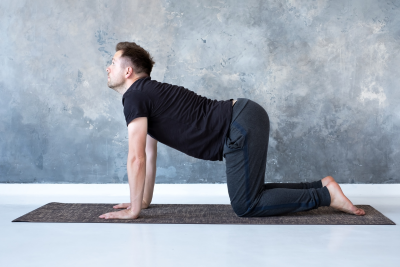
Cat Cow Pose
To improve your posture in general and increase spinal awareness, try the Cat Cow pose daily. As you inhale you are trying to create an anterior tilt to the pelvis with tailbone facing up, and exhale to a posterior tilt with your tailbone turned to the ground.
Instructions –
- Start on all fours with shoulders over wrists and hips over knees, and tops of feet pushing down on the floor. Lengthen from your head to tailbone.
- For the Cat pose, as you exhale, use your abs to curl your spine to the ceiling and tuck tailbone down. Keep length in the neck, but your chin will reach down and in towards your chest, and ears will be besides biceps.
- For the Cow pose, inhale and scoop your pelvis so your tailbone is now up and then your belly will drop down. Keep shoulder blades wide, drawing them away from ears, then lift your chin and chest to look up if possible.
- Continue for a few rotations, always leading the movement with the breath.
Downward Facing Dog
This exercise is useful to open the anterior chest wall and shoulders and counteract the roundness and tightness in your upper back. You may need to build up to this exercise as it requires some upper body strength.
Instructions –
- From all fours, tuck your toes and lift your hips, reaching hips towards ceiling
- Reach your heels back towards the ground/mat
- Drop your head so it is long and fingers and wrists stay parallel to the mat
- If there is pressure on wrists you can press into the knuckles of forefingers and thumbs.
- Draw your shoulder blades down your back to create space in your neck, and repeat for a few long, deep breaths.
Standing Forward Fold
This exercise stretches the neck and hamstrings, which is great for a tight neck and hips from sitting all day.
Instructions –
- Take shoes off and begin with feet hip distance apart. Think of keeping the crown of your head tall, and lifting your spine up and over your tummy, as you breathe out slowly, and gently roll forward and down, vertebrae by vertebrae. Try to let your hands touch the floor or hang down without straining.
- Various options then include cradling your elbows with opposite hands and rocking gently as you breathe deeply, or bending your knees and lifting feet to put palms face up underneath your feet. Alternatively if this is too hard, you can put a text book or small box on the floor to reduce the stretch.
If you need assistance with any of these exercises, or require further advice, please contact your Physiotherapist, or other health professional. It is really important that bad posture is dealt with swiftly, to ensure the bad habits are corrected and to prevent more serious health issues in the future.
Ergonomic Workstation Set up Tips
A poorly configured workstation can also cause bad posture and subsequent back and neck issues. With children now back to school, and parents working more and more in home offices, here are some general guidelines to follow when setting up your workspace.
But don’t forget, the following tips are just a piece in the puzzle. You also need to monitor the time you spend in front of your computer or at your desk, change position often, take breaks, stretch often, and keep your back and neck strong by doing regular exercise.
- Choose a desk and chair combo that suits your body
- Choose a fully adjustable chair and ensure your feet are flat on the floor. If they don’t reach use a footstool
- Your knees should be at the same level of slightly below your hips, and there should be a small gap at the back of your knees and the front edge of the seat
- The lower curve of the chair back should support your lower back, or use a lumbar roll
- The top of the chair should reach your mid back or if higher,must follow your backs curve
- The armrests will allow you to reach your keyboard without extending your arms
- The height of your desk and chair should allow your elbows to hang at a 90 degree angle and both shoulders and arms are relaxed
- Consider a height adjustable desk so that you can configure the desk and chair to your liking and it gives you the extra option of standing up for intervals throughout the day.
- The top of the computer screen must be level with your eyes, so if you are using a laptop, you’ll need to prop up appropriately
- Your main screen, should be straight ahead of you
- The screen must be close enough to read easily. If you cannot, don’t lean forward, simply increase the zoom setting, or look at getting glasses.
- Your keyboard needs to be the correct size for your body so that you don’t have to turn your arms in or out excessively.
- The keyboard should be positioned so that your elbows are at a 90 degree angle which will ensure your wrists don’t have to bend up or down excessively
- When talking to clients on the phone, use earbuds or a headset to avoid using your neck to hold the phone whilst you type
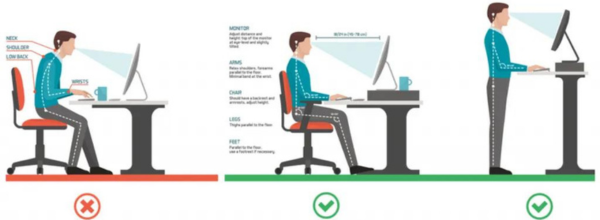
Physiotherapy for Posture related issues at Sandgate Physical Health Clinic
Our experienced Physiotherapists at SPHC, are able to diagnose and treat Text neck and all types of back and neck posture related issues, in people of all ages. Please contact us if you have any questions, or have no reduction of symptoms after trying the above suggestions.
Call us today on 38691099 or BOOK ONLINE.
VIEW OTHER RELATED ARTICLES –
9 Ways to Improve your Posture
Tips to Improve your Bad Posture Habits

